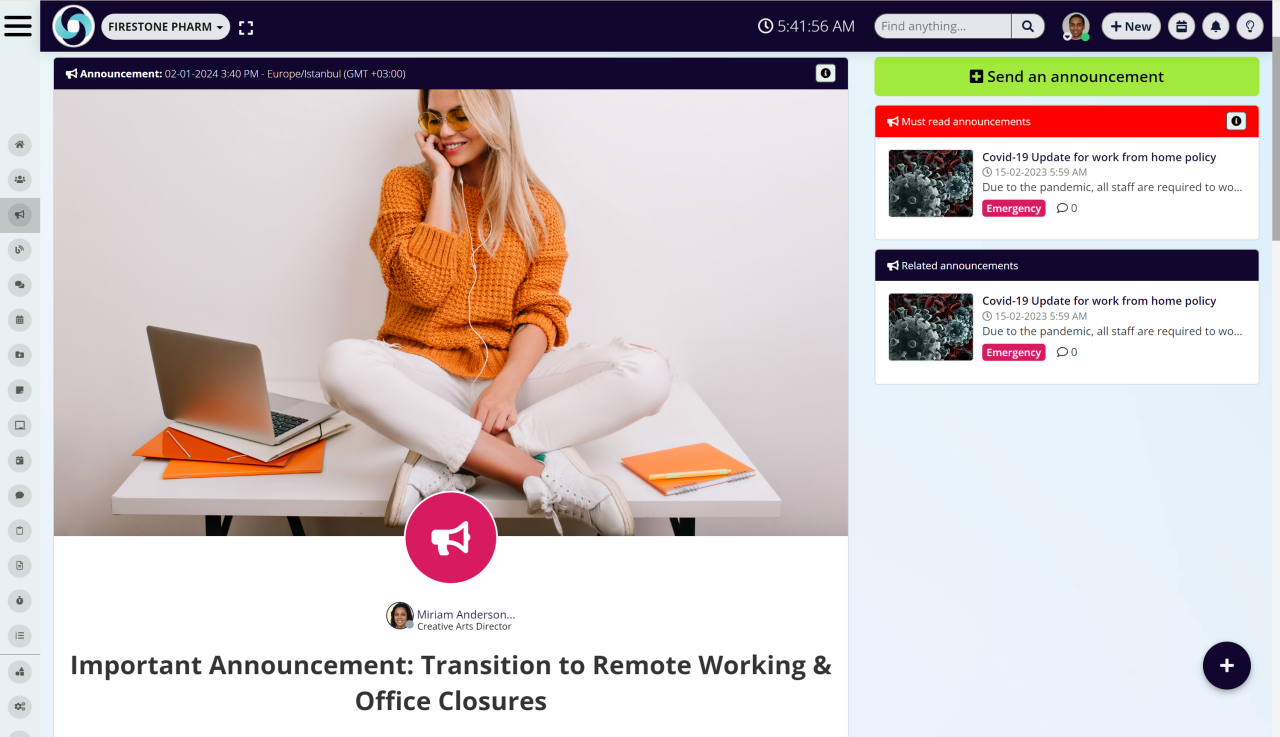Insight Blog
Agility’s perspectives on transforming the employee's experience throughout remote transformation using connected enterprise tools.
9 minutes reading time
(1810 words)
Intranet Style Guide – Getting Started With Writing Content For The Intranet
Learn how to write engaging intranet content with our style guide. Boost internal comms, clarity & engagement. Start optimizing today!
If you are new to the game of intranet, it can be a little confusing to understand how to get started with content. Employees use the system to find information fast and management uses it to engage employees with targeted information.
This means your focus should be on access and content. The design of your intranet and the quality of the content should be balanced to make it appealing and useful.
In this guide, we talk about the intranet-style guide that helps you create effective content. We also look at some examples for the intranet content to make it easy for you to get started with writing for the intranet.
Intranet Style Guide – Getting Started
An intranet styling guide includes the guidelines for the style of writing, fonts, formatting, branding and more. Following the guide ensures consistency across the website and user engagement.
The style guide for intranet generally contains the following components:
Intranet Name
This is a highly significant aspect of intranet branding. There are several strategies to get a creative name, the most important being crowdsourcing.
Though organizations fear crowdsourcing produces bad results, you can avoid negative impact by defining the purpose of the intranet. When your goals are clear, employees can come up with the name that suits it well.
Logo
A clear and simple logo that includes the intranet name is great. Make sure you maintain square proportions as much as you can. Also, avoid the use of an all-white logo.
Lastly, you should avoid using the logo with the intranet name as it will not only affect the appeal but also make it difficult for people to understand where they should click.
Footer
The footer is aimed at helping users find other relevant pages on the intranet as well as the contact information for the team. A large footer section is most common but you should ensure the links are up to date.
You should also avoid putting social media icons in the footer if you already have feeds from social media on the website. Also, see that it is not too flashy and busy – keep the number of sections less than seven.
Writing Content For The Intranet
Readers generally have a limited time available to go through the content on the intranet. This is why it is important that writing is effective enough to grab attention.
Title
It is really important to use a meaningful headline that tells what the article is about. This sparks interest and a sense of curiosity in readers.
You may want to use longer titles but make sure it doesn't make the content distracting and difficult. Use six words or lesser for the title.
Subheading
This part of the content helps explain the content. You can sometimes use categories depending on the system you are using.
The Content
The article should start with a description of what you are telling about. This helps the reader decide whether he should continue reading further. The first paragraph should be short, three-four sentences.
Keep sentences clear and concise and avoid writing long sentences that get confusing. Try to use minimum abbreviations.
Describe one idea within a paragraph and split it between paragraphs if you need to write more. See that you don't use bold fonts too much. This can interrupt the flow of reading and makes the content ineffective.
Be sure to use a spellchecker when writing content on the intranet to correct your grammar and confusing words. For example, understanding the concept of demeanor will help you use it better in a sentence because, unlike the word "demean," it doesn't have the same negative connotation
Intranet Announcement Examples
One of the best examples of intranet content is a new employee announcement. Employees love to learn about new hires, so it is a good idea to update the staff on new employee joining.
This type of announcement on the intranet not only helps the new employee feel welcomed but also help other employees understand how they should interact and work with the person.
A new employee announcement should include the details of the employee like their basic information, where they come from, the hobbies and job role. You can also include some fun facts about the person and details of how others can get in touch with the new employee.
Some other simple examples of announcements on the intranet include staff schedules updated each day in the morning and key event dates. Employees can be encouraged to share updates from their department on the intranet to boost engagement and connection within the company.
Here are six effective intranet announcement examples with different use cases:
- New Policy Implementation
Subject: "Updated Remote Work Policy Effective June 1st"
Body:
"We're introducing a revised remote work policy to support flexible arrangements. Key changes include:
- Core hours (10am-3pm) for team collaboration
- Updated equipment reimbursement process
- Monthly in-office days (team-specific)
📌 Action Required: Review the full policy [here] and submit questions by May 25th.
Best,
HR Team"
- IT System Maintenance
Subject: "Scheduled Downtime: Email System Upgrade (May 20, 8-10pm)"
Body:
🔧 What's happening: Critical security upgrade to Outlook
⏰ Impact: 20-minute access interruption
✅ Preparation: Save drafts before maintenance window
Contact IT Helpdesk with urgent concerns.
- Employee Recognition
Subject: "Congratulations to Our Q2 Innovation Award Winners!"
Body:
Join us in celebrating:
🏆 Sarah Kim (Marketing) - AI chatbot project
🏆 Dev Patel (Ops) - Process automation tool
Their work saved 120+ hours this quarter! Read their stories [here].
#EmployeeExcellence
- Office Reopening Update
Subject: "HQ Reopening: Desk Booking Now Available"
Body:
📍 New: Hot-desking system via the Workplace app
🧼 Enhanced cleaning protocols in place
🍏 Complimentary snacks restarting June 1
Book your space → [link]
- Learning Opportunity
Subject: "Enroll Now: Leadership Webinar Series (Starts June 5)"
Body:
📢 New offering: "Managing Hybrid Teams" certification
👩💻 4 virtual sessions + peer workshops
🎯 For: Managers and aspiring leaders
🔗 Register by May 30 → [link]
- Emergency Alert
Subject: "URGENT: Building Evacuation Drill - Tomorrow 10am"
Body:
🚨 Mandatory participation
📍 Assembly point: North parking lot
ℹ️ Floor wardens will guide teams
📱 Review evacuation routes [here]
Safety First!
Pro Tips:
- Use emojis sparingly (max 3 per post)
- Put deadlines/dates in bold
- Include clear CTAs (links/actions)
- Tag relevant departments when needed
Intranet Article Example
When you are writing for the employees in your company, you have endless possibilities to encourage them to engage.
An example of a well-crafted Intranet article is the one that tells everybody about a new office that just opened. So, you can use the title 'New Office Opens in Canada' and then describe where exactly it is located, when it opened and how it will help expand the business.
However, as an employee, one would not want to click on the header and look into the article. This means you should take a personalized approach and target the different departments.
For example, it can be 'What keeps our Canadian customers awake in the night?' for the customer support team. You can use something like 'Canada opens the doors to new prospects' to target the sales department.
Header: Finance Update | May 2024
Introduction:
Submitting expense reports just got easier! Our updated process saves time and reduces errors. Whether you're traveling for work or purchasing supplies, follow these steps to get reimbursed faster.
Key Changes to Note (Effective June 1):
✅ Mobile-Friendly Submissions – Upload receipts via the company app
✅ Auto-Approval – Expenses under $100 with valid receipts are instantly processed
✅ Faster Payments – Reimbursements now within 3 business days (down from 5)
Step-by-Step Guide
- Log in to the Employee Portal > Expenses tab
- Upload clear photos/scans of itemized receipts
- Select the correct budget code (dropdown menu available)
- Submit – You'll receive a confirmation email with tracking #
Pro Tip: Bookmark the [Expense Policy page] for quick reference.
Common Mistakes to Avoid
❌ Blurry receipt images (ensure dates/amounts are legible)
❌ Missing project codes (delays approval)
❌ Personal expenses accidentally submitted
Need Help?
📞 Contact Finance Helpdesk (ext. 555)
📅 Attend a Live Q&A on May 28 – [Register Here]
Footer:
"We're committed to simplifying admin tasks so you can focus on meaningful work!"
– The Finance Team
Why This Works:
✔ Scannable format with clear sections
✔ Actionable steps and troubleshooting
✔ Balances policy details with user-friendly tone
✔ Visual cues (icons, bold text) guide the reader
Intranet Content Ideas
There are several types of engaging intranet content but all of them share similar characteristics. Firstly, you don't want to make the mistake of creating content just for the sake of having it.
Overloading your employees with irrelevant information will only drop the engagement levels. Here are some of the intranet content ideas that help you enhance the employee experience.
Message from the Executive – Employees want that they are kept informed. They should be kept updated about the company.
- Big Wins – Each department contributes to the success so let the employees know about the big wins of the company.
- Customer Stories – A great way to engage employees is to tell them how customers like products or services. You can upload some testimonials or use a case study to create content.
- Contests and Polls – Introducing contests and polls encourage employees to participate and interact. You can consider something simple like a photo caption contest or a poll 'Are you happy with our current coffee vendor?'
- Humor – If you make it funny, your employees will surely read your content. If you are out of ideas, you can ask employees to submit funny stories.
This guide should help those who wish to create relevance through their intranet content. While these tips and suggestions should guide you better, they are not hard and fast rules. The ultimate goal is to make the information centrally available, easily readable and relevant.
The Benefits of an Intranet Style Guide for Content Creation
An Intranet Style Guide ensures consistency, clarity, and professionalism across all internal communications. By standardizing tone, formatting, and terminology, it helps employees create content that is easy to read, understand, and engage with.
Key Benefits:- Consistency – Maintains a unified voice and branding across departments.
- Improved Readability – Clear guidelines on structure, headings, and bullet points enhance comprehension.
- Time Savings – Reduces back-and-forth edits with predefined rules for writing.
- Better Engagement – Encourages concise, action-driven content that resonates with employees.
- Accessibility Compliance – Ensures content meets inclusivity standards (e.g., alt text, plain language).
- SEO for Internal Search – Optimized keywords help employees find information faster.
A well-crafted style guide also fosters collaboration by aligning teams on best practices, reducing confusion, and reinforcing company culture. Whether announcing policies, sharing updates, or posting news, a structured approach keeps content professional and purposeful.
Categories
Blog
(2590)
Business Management
(318)
Employee Engagement
(204)
Digital Transformation
(172)
Intranets
(119)
Growth
(118)
Remote Work
(61)
Sales
(48)
Collaboration
(37)
Culture
(29)
Project management
(29)
Customer Experience
(26)
Knowledge Management
(21)
Leadership
(20)
Comparisons
(5)
Ready to learn more? 👍
One platform to optimize, manage and track all of your teams. Your new digital workplace is a click away. 🚀
Free for 14 days, no credit card required.














